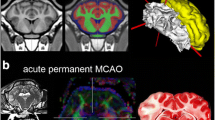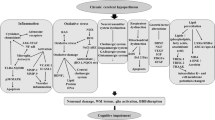Abstract
Vascular cognitive impairment and dementia (VCID) is the most common etiology of dementia in the elderly. Both, vascular and Alzheimer’s disease, pathologies work synergistically to create neurodegeneration and cognitive impairments. The main causes of VCID include hemorrhage/microbleed (i.e., hyperhomocysteinemia), cerebral small vessel disease, multi-infarct dementia, severe hypoperfusion (i.e., bilateral common carotid artery stenosis), strategic infarct, angiopathy (i.e., cerebral angiopathy), and hereditary vasculopathy (i.e., cerebral autosomal dominant arteriopathy with subcortical infarcts and leukoencephalopathy). In this review, we will discuss the experimental animal models that have been developed to study these pathologies. We will discuss the limitations and strengths of these models and the important research findings that have advanced the field through the use of the models.
Similar content being viewed by others
References
Arvanitakis Z, Leurgans SE, Barnes LL, Bennett DA, Schneider JA (2011) Microinfarct pathology, dementia, and cognitive systems. Stroke. doi:10.1161/STROKEAHA.110.595082
Bink DI, Ritz K, Aronica E, van deer Weerd L, Daemen MJ (2013) Mouse models to study the effect of cardiovascular risk factors on brain structure and cognition. J Cereb Blood Flow Metab. doi:10.1038/jcbfm.2013.140
Cognat E, Cleophax S, Domenga-Denier V, Joutel A (2014) Early white matter changes in CADASIL: evidence of segmental intramyelinic oedema in a pre- clinical mouse model. Acta Neuropathol Commun. doi:10.1186/2051-5960-2-49
Davis J, Xu F, Deane R, Romanov G, Previtt ML, Zeigler K et al (2004) Early-onset and robust cerebral microvascular accumulation of amyloid beta-protein in transgenic mice expressing low levels of a vasculotropic Dutch/Iowa mutant form of amyloid beta-protein precursor. J Biol Chem. doi:10.1074/jbc.M312946200
Ehret F, Vogler S, Pojar S, Elliott DA, Bradke F, Steiner B, Kempermann G (2015) Mouse model of CADASIL revels novel insights into Notch3 function in adult hippocampus neurogenesis. Neurobiol Disease. doi:10.1016/j.nbd.2014.12.018
Hainsworth AH, Markus HS (2008) Do in vivo experimental models reflect human cerebral small vessel disease?. J. Cereb Blood Flow Metab, A systemic review. doi:10.1038/jcbfm.2008.91
Hainsworth AH, Brittain JF, Khatun H (2012) Pre-clinical models of human cerebral small vessel disease: utility for clinical application. J Neuro Sci. doi:10.1016/j.jns.2012.05.046
Hallacoglu B, Sassaroli A, Fantini S, Troen AM (2011) Cerebral perfusion and oxygenation are impaired by folate deficiency in rat: absolute measurements with noninvasive near-infrared spectroscopy. J Cereb Blood Metab. doi:10.1038/jcbfm.2011.13
Hattori Y, Enmi J, Kitamura A, Yamamoto Y, Saito S, Takahashi Y (2015) A novel mouse model of subcortical infarcts with dementia. J Neurosci. doi:10.1523/JNEUROSCI.3970-14.2015
Hernandez-Guillamon M, Martinez-Saez E, Delgado P, Domingues-Montanari S, Boada C, Penalba A et al (2011) MMP-2/MMP-9 plasma level and brain expression in cerebral amyloid angiopathy-associated hemorrhagic stroke. Brain Pathol. doi:10.1111/j.1750-3639.2011.00512.x
Herzig MC, Winkler DT, Burgermeister P, Pfeifer M, Kohler E, Schmidt SD et al (2004) Aβ is targeted to the vasculature in a mouse model of hereditary cerebral hemorrhage with amyloidosis. Nat Neurosci. doi:10.1038/nn1302
Holland PR, Searcy JL, Salvadores N, Scullion G, Chen G, Lawson G (2015) Gliovascular disruption and cognitive deficits in a mouse model with features of small vessel disease. J Cereb Blood Flow Metab. doi:10.1038/jcbfm.2015.12
Jadavijia NM, Farr TD, Lips J, Khalil AA, Boehm-Sturm P, Foddis M et al (2015) Elevated levels of plasma homocysteine, deficiencies in dietary folic acid and uracil-DNA glycosylase impair learning in a mouse model of vascular cognitive impairment. Behav Brain Res. doi:10.1016/j.bbr.2015.01.040
Jiwa NS, Garrard P, Hainsworth AH (2010) Experimental models of vascular dementia and vascular cognitive impairment: a systematic review. J Neurochem. doi:10.1111/j.1471-4159.2010.06958.x
Joutel A, Monet-Lepretre M, Gosele C et al (2010) Cerebrovascular dysfunction and microcirculation rarefaction precede white matter lesions in a mouse genetic model of cerebral ischemic small vessel disease. J Clin Invest. doi:10.1172/JCI39733
Kaiser D, Weise G, Miller K, Scheibe J, Pisel C, Baasch S et al (2014) Spontaneous white matter damage, cognitive decline and neuroinflammation in middle- aged hypertensive rats: an animal model of early-stage cerebral small vessel disease. Acta Neuropathol Commun. doi:10.1186/s40478-014-0169-8
Kamath AF, Chauhan AK, Kisucka J, Dole VS, Loscalzo J, Handy DE, Wagner DD (2006) Elevated levels of homocysteine compromise blood-brain barrier integrity in mice. Blood. doi:10.1182/blood-2005-06-2506
Kulic L, McAfosse J, Welt T, Tackenberg C, Spani C, Wirth F et al (2012) Early accumulation of intracellular fibrillar oligomers and late congophilic amyloid angiopathy in mice expressing the Osaka intra-Aβ APP mutation. Transl Psychiatry. doi:10.1038/tp.2012.109
Kumar-Singh S (2009) Hereditary and sporadic forms of abeta-cerebrovascular amyloidosis and relevant transgenic mouse models. J. Mol. Sci, Int. doi:10.3390/ijms10041872
Lentz SR, Erger RA, Dayal S, Maeda N, Malinow MR, Heistad DD et al (2000) Folate dependence of hyperhomocysteinemia and vascular dysfunction in cystathionine beta-synthase-deficient mice. Am J Physiol Heart Circ Physiol. doi:10.1093/hmg/ddn097
Li JG, Pratico D (2015) High levels of homocysteine results in cerebral amyloid angiopathy in mice. J Alzheimers Dis. doi:10.3233/JAD-141101
Li JG, Chu J, Barrero C, Merali S, Pratico D (2014) Homocysteine exacerbated beta- amyloid pathology, tau pathology, and cognitive deficit in a mouse model of Alzheimer disease with plaques and tangles. Ann Neurol. doi:10.1002/ana.24145
Miao J, Xu F, Davis J, Otte-Holler I, Verbeek M, Van Nostrand WE (2005) Cerebral microvascular amyloid β protein deposition induces vascular degeneration and neuroinflammation in transgenic mice expressing human vasculotripic mutant amyloid β precursor protein. Am J Pathol. 10.1523/JNEUROSCI.1306-05.2005
Mikael LG, Wang XL, Wu Q, Jiang H, Maclean KN, Rozen R (2009) Hyperhomocysteinemia is associated with hyperglyceridemia in mice with methylenetetrahydrofolate reductase deficiency. Metab, Mol, Genet. doi:10.1016/j.ymgme.2009.05.011
Nakaji L, Ihara M, Takahashi C, Itohara S, Noda M, Takahashi R et al (2006) Matrix metalloproteinase-2 plays a critical role in the pathogenesis of white mater lesion after chronic cerebral hypoperfusion in rodents. Stroke. doi:10.1161/01.STR.0000244808.17972.55
Neto CJBF, Paganelli RA, Benetoli A, Lima KCM, Milani H (2005) Permanent, 3-stage, 4-vessel occlusion as a model of chronic and progressive brain hypoperfusion in rats: a neurohistological and behavioral analysis. Behav Brain Res. doi:10.1016/j.bbr.2004.12.016
Niedowicz DM, Reeves VL, Platt TL et al (2014) Obesity and diabetes cause cognitive dysfunction in the absence of accelerated β-amyloid deposition in a novel murine model of mixed or vascular dementia. ACTA Neuropathol Commun. doi:10.1186/2051-5960-2-64
Nishio K, Ihara M, Yamasaki N et al (2010) A mouse model characterizing features of vascular dementia with hippocampal atrophy. Stroke. doi:10.1161/STROKEAHA.110.581686
Pereira FM, Ferreira EDF, Weffort de Oliveira RM, Milani H (2012) Time-course of neurodegeneration and memory impairment following the 4-vessel occlusion/internal carotid artery model of chronic cerebral hypoperfusion in middle-age rats. Behav Brain Res. doi:10.1016/j.bbr.2012.01.023
Roman GC (2002) Vascular dementia revisited: diagnosis, pathogenesis, treatment, and prevention. Med Clin North Am. doi:10.1016/S0025-7125(02)00008-1
Roof RL, Schielke GP, Ren X, Hall ED (2001) A comparison of long-term functional outcome after 2 middle cerebral artery occlusion models in rats. Stroke. doi:10.1161/hs1101.097397
Sakai N, Yanai K, Ryu JH, Nagasawa H, Hasegawa T, Sasaki T, Kogure K, Watanabe T (1996) Behavioral studies on rats with transient cerebral ischemia induced by occlusion of the middle cerebral artery. Behav. Brain Res. doi:10.1016/0166-4328(95)00232-4
Shibata M, Yamasaki N, Miyakawa T, Kalaria RN, Fuijita Y et al (2007) Selective impairment of working memory in a mouse model of chronic cerebral hypoperfusion. Stroke. doi:10.1161/01.STR.0000143725.19053.60
Snyder HM, Corriveau RA, Craft S, Faber JE, Greenberg S, Knopman D et al (2014) Vascular contributions to cognitive impairment and dementia including Alzheimer’s disease. Alzheimer’s Dementia. doi:10.1016/j.jalz.2014.10.008
Sontag TA, Fuermaier ABM, Hauser J, Kaunzinger I, Tucha O, Lange KW (2013) Spatial memory in spontaneously hypertensive rats (SGR). PLoS ONE. doi:10.1371/journal.pone.0074660
Sudduth TL, Powell DK, Smith CD, Greenstein A, Wilcock DM (2013) Induction of hyperhomocysteinemia models vascular dementia by induction of cerebral microhemorrhages and neuroinflammation, J Cereb Blood Flow Metab. doi:10.1038/jcbfm.2013.1
Sudduth TL, Weekman EM, Brothers HM, Braun K, Wilcock DM (2014) Beta-amyloid deposition is shifted to the vasculature and memory impairment is exacerbated when hyperhomocysteinemia is induced in APP/PS1 transgenic mice. Alzheimer’s Res Therapy. doi:10.1186/alzrt262
Takeda S, Sato N, Uchio-Yamada K, Sawada K, Kunieda T, Takeuchi D, Kurinami H, Shinohara M, Rakugi H, Morishita R (2010) Diabetes-accelerated memory dysfunction via cerebrovascular inflammation and Abeta deposition in an Alzheimer mouse model with diabetes. Natl Acad. Sci. USA, Proc. doi:10.1016/j.jns.2012.05.04710.1073/pnas.1000645107
Tayebti SK, Tomassoni D, Amenta F (2012) Spontaneously hypertensive rat as a model of vascular brain disorder: microanatomy, neurochemistry, and behavior. J Neurol Sci. doi:10.1016/j.jns.2012.05.047
Toyama K, Koibuchi N, Uekawa K, Hasegawa Y, Kataoka K, Katayama T et al (2013) Apoptosis signal-regulating kinase 1 is a novel target molecule for cognitive impairment induced by chronic cerebral hypoperfusion. Arterioscler Thromb Vasc Biol. doi:10.1161/ATVBAHA.113.302440
Troen AM, Shea-Budgell M, Shukitt-Hale B, Smith DE, Selhub J, Rosenberg IH (2007) B-vitamin deficiency cause hyperhomocysteinemia and vascular cognitive impairment in mice. PNAS. doi:10.1073/pnas.0805350105
Wallays G, Nuyens D, Silasi-Mansat R, Souffreau J, Callaerta-Vegh Z, Nuffelen AV et al (2011) Notch3Arg170Cys knock-in mice display pathologic and clinical features of the neurovascular disorder cerebral autosomal dominant arteriopathy with subcortical infarcts and leukoencephalopathy. Arterioscler Thromb Vasc Biol. doi:10.1161/ATVBAHA.111.237859
Yamada M, Ihara M, Okamoto Y, Maki T, Washida K, Kitamura A et al (2011) The influence of chronic cerebral hypoperfusion on cognitive function nd amyloid beta metabolism in APP overexpressing mice. PLoS ONE. doi:10.1371/journal.pone.0016567
Yoshizaki K, Adachi K, Kataoka S, Watanabe A, Tabira T, Takahashi K, Wakita H (2008) Chronic cerebral hypoperfusion induced by right unilateral common carotid artery occlusion causes delayed white matter lesions and cognitive impairment in adult mice. Exp Neurol. doi:10.1016/j.expneurol.2007.12.005
Yun HS, Park MS, Ji EY, Kim TW, Ko IG, Kim HB, Kim H (2014) Treadmill exercise ameliorates symptoms of attention deficit/hyperactivity disorder through reducing Purkinje cell loss and astrocytic reaction in spontaneous hypertensive rats. J Exerc Rehab. doi:10.12965/jer.140092
Author information
Authors and Affiliations
Corresponding author
Rights and permissions
About this article
Cite this article
Gooch, J., Wilcock, D.M. Animal Models of Vascular Cognitive Impairment and Dementia (VCID). Cell Mol Neurobiol 36, 233–239 (2016). https://doi.org/10.1007/s10571-015-0286-3
Received:
Accepted:
Published:
Issue Date:
DOI: https://doi.org/10.1007/s10571-015-0286-3




